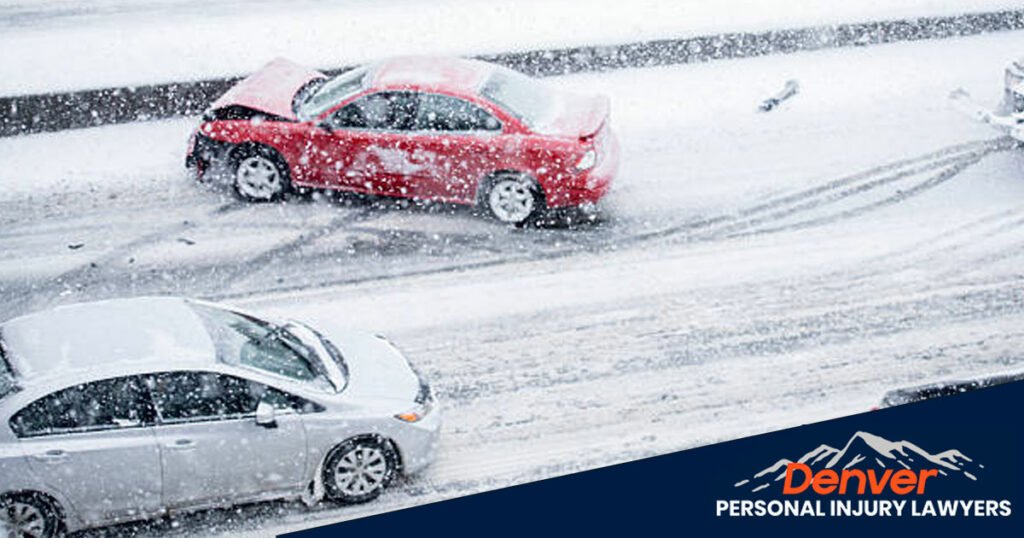Winters in Colorado can be brutal. During the winter months, weather-related car accidents are more likely. Rain, mist, ice, snow, and sleet provide dangerous conditions for drivers. That’s because they can make roads more slippery and less visible. With inevitable harsh weather conditions, drivers are sometimes bound to lose control of their vehicles. All it takes is one split second for a car to lose control and cause an accident.
There are about 1,312,000 weather-related car accidents in the US every year. Colorado’s first sight of snow is usually around October, but it can come as early as September and continue until April. This year it came particularly early, and we saw snowfall in August. That means Colorado gets snow for over half the year! In addition, snow typically falls heavily in January and happens for several days in a row. As a result, Colorado contributes to many winter-weather-related car accidents. Even if drivers are extra careful, they can still get into an accident due to someone else’s mistake. The poor weather conditions make it more likely for the tiniest errors to lead to major collisions.
Table of Contents
ToggleWhat Kind of Dangers Are Present While Driving In Winter Weather In Colorado?
According to the Federal High Administration, 24% of weather-related accidents occur on snowy, slushy, or icy pavement, and 15% happen during snowfall or sleet. The Colorado Department of Transportation (CDOT) provides free public safety tips for driving in winter weather. But, just because we all know how to, doesn’t mean we can completely avoid accidents. They are bound to happen sometimes with inclement weather. In addition, driver error increases the risk of injury when paired with bad weather.
Here are some winter weather conditions that can lead to accidents in Colorado:
Rain
Rain immediately reduces visibility for drivers and makes the roads slippery for tires. In addition, cars have less control on wet roads than on dry ones. Consequently, you need more time to stop in the rain. Braking too hard can lead to loss of control of the vehicle.
Snow and Sleet
Snow has various impacts on driving conditions. For starters, cold weather can damage your car. Snow accumulation can also cause obstructions on roads or get packed onto traffic signs and signals. One whiteout can cause a significant accident, resulting in severe injuries or fatalities.
Icy Roads
Ice on the roads is a severe hazard for drivers, especially black ice. Black ice is harder to see and, therefore, more insidious. It can make your car skid off-road or into another car.
Fog
Fog will drastically reduce visibility. Many people think turning on their high beams will be helpful, but it makes it harder to see. In addition, a combination of fog and mist can be problematic in the winter months and lead to a crash.
High-Speed Winds During a Winter Storm
Winter storms and blizzards can bring strong winds that impact visibility. The winds bring debris and cause particles to circulate higher in the air. Furthermore, heavy winds can cause your car to lose control.
What Are Common Injuries Caused By Traffic Collisions on Icy Roads?
Even if drivers take all precautions necessary, winter weather can still cause accidents. Unfortunately, icy roads often cause some of the worst accidents. The outcome can be disastrous for people involved in a crash on icy or snowy roads. The driver and passengers may experience physical injuries and mental distress from the accident. Financial damages are also a concern, ranging from property damage to medical bills and lost wages.
Some of the most common injuries after a weather-related accident include:
- Traumatic brain injury (TBI)
- Neck Injury (like Whiplash)
- Spinal cord injuries (which can cause permanent disability)
- Broken bones and bone fractures
- Strains and sprains
- Amputation of a limb in very severe cases
- Paralysis
Car accident victims also often experience mental distress after a car accident, including:
- Anxiety and depression
- PTSD
- Stress
- Embarrassment from specific injuries or an accident-related disability
- Insomnia
- Inability to focus
Who Is At Fault For Weather-Related Accidents in Colorado?
Sometimes it’s unclear who is at fault after a winter weather accident. But Colorado has laws that govern driving rules in adverse weather conditions. For example, Colorado Revised Statutes CRS section 42-4-1101 (1) holds drivers responsible for failing to drive at a “reasonable and prudent” speed on snow or ice. In addition, Colorado Statute CRS section 42-4-1008 (1) instructs drivers to keep enough distance between other cars. Speeding or failing to use reasonable care in icy or snowy roadway conditions is considered negligent under Colorado Statute Title 42-4-1401 or careless under Title 42 section 4-1402.
What are the Common Causes of a Winter Weather Accident In Colorado?
A driver who fails to drive in a “reasonable and prudent” manner could cause an accident. Even someone who does drive cautiously could get into an accident. Sadly, it can happen to almost anyone in bad weather. Here are some of the leading causes of winter accidents in Colorado:
Over-Speeding on Snowy Roads
Speeding is never good but can be particularly disastrous during winter. Drivers should use good judgment to reduce their speed for snow or ice. The stakes are very high when driving on black ice or other harsh weather, especially with low visibility. Speeding in harsh weather is a sure recipe for disaster.
Cruise Control
While cruise control is convenient for the highway, drivers should avoid it in winter weather. That’s because you need more time to react and stop your car in winter weather. If you react too late, you could lose control of your car and cause a crash.
Failing to Obey Traffic Rules
Violating basic traffic rules can lead to accidents. Traffic rules are in place to regulate traffic and ensure the safety of all vehicle occupants. For example, a driver who runs a red light or fails to yield can cause a fatal accident.
Distracted Driving
A distracted driver is worse than a drunk driver in terms of focus and control in winter driving conditions. When a driver has their attention diverted to another passenger, a call, or a text, they can lose control of their vehicle and have prolonged reaction times. This leads to vehicle accidents in the winter weather.
Lack of Proper Equipment
If you live in a snowy region, it’s imperative to use snow or winter tires for better traction. Colorado’s average snowfall is 60-100 inches annually. Without proper equipment, you could easily skid on wet or icy pavement.
What Damages Can I Recover After a Winter Car Accident?
After sustaining injuries, accident victims usually go through a hard time. It can be physically and emotionally taxing to deal with the aftermath of a crash while you’re injured. In addition, you might have expenses racking up from medical bills, car repairs, and more. Therefore, holding the liable party accountable for your losses is essential. You can seek compensation for all the damages you’ve suffered. Some possible damages you can recover after a car accident include:
- Medical bills
- Lost wages
- Future lost earning capacity.
- Physical therapy and rehab
- Pain and suffering
Steps to Take After a Colorado Winter Weather Accident
Here are some steps to remember if you get into a winter weather accident. Your priority should be to ensure everyone’s safety. While you may have a flood of thoughts and emotions, remember to get the incident appropriately documented.
- Call the police and wait for them to arrive to ensure you have an official police report with your statement.
- Gather as much evidence as you can as soon as possible. Take pictures of the accident scene, any injuries, and vehicle damage.
- Get contact and insurance information from all parties involved in the accident.
- Seek medical attention right away. If you delay getting checked, you could jeopardize your personal injury claim.
- Refrain from speaking to insurance companies until you consult a Denver car accident attorney
Winter Driving Essentials Check-List From the Colorado Department of Transportation
Be sure to keep the following items in your car to stay prepared for winter driving:
- A strong and sturdy scraper, snow brush, or snow shovel
- A flashlight with backup batteries
- A thick blanket or sleeping bag
- Water (a gallon jug or bigger)
- First-aid kit and any essential medicines
- Tire chains
- Tow strap
- Jumper cables
- Flares and reflectors to warn other motorists
- Battery radio for emergency broadcasting
Colorado Department of Transportation (CDOT) Tips For Driving In Snow
By taking a little extra caution, you can significantly reduce your odds of getting into a snow accident. Here are some safety tips to remember:
- Take the time to clear snow and ice off your car before driving.
- Driving requires acceleration, turning, and braking. While driving in winter, you should only do one at a time. Doing any of them simultaneously can cause a spin-out or slide-out.
- Switch to a lower gear when traveling downhill and gently tap the brakes to help keep traction.
- Keep your momentum when going uphill, so you don’t get stuck.
- Use low beams while driving at night. High beams decrease visibility.
- Drive slow. Most crashes are caused by driving too fast for the given conditions.
- If you get into a multi-vehicle crash, stay in your car. It’s safer than getting out.
- Keep right except to pass.
- Be a defensive driver and use signals. In addition, look ahead and plan for abrupt stops or turns
- Wear your seatbelt and never drive impaired.
Contact a Denver Winter Car Accident Attorney
Don’t wait to file a claim if you sustained injuries in a winter weather accident. We can help you recover the compensation you deserve for your losses. Contact us today for a free case review.
















